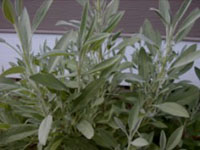
Other articles you might enjoy:
1. The Simple, Essential Herb Garden
2. The Spice Buyer's Journal: Sage Field Report
4. Herb of the Year 2005: Oregano and Friends
Make the most of culinary herbs and spices.
All About Sage
by Sandra Bowens

Nevadans are probably the most familiar with sage. Their state flower blanketing huge portions of the high desert is actually sagebrush. It is excellent fodder for the wild horses and other animals but has no place on our dinner tables. The sage that we consume is garden sage, botanical name salvia officinalis.
This name is derived from the Latin word meaning health or healing powers. Sage has been used as a medicinal herb far longer than it has been a culinary herb. It was indispensable in the Dark Ages. The ancient Greeks and Romans administered sage for everything from snakebite to promoting longevity. Sage was steeped in hot water, as for tea, before tea became known. Introduced to American palettes in the 1800’s, medicinal usage of sage declined as the culinary use increased.
This greyish-green leafed member of the mint family had actually grown into the most popular herb in American cooking until after World War II, when oregano took over as the number one seasoning. Slightly bitter in flavor and highly aromatic, sage is one of the main ingredients in poultry seasoning. It enhances meats and poultry as well as most vegetables.
Fresh sage is far less bitter than dried sage but in either form, a little goes a long way. It is not particularly palatable fresh so add it sooner in the cooking process rather than near the end as with most fresh herbs. Sage will stand up to long cooking times making it a natural for stewed or braised dishes.
The shrubby sage plant is native to Mediterranean regions although it is now cultivated in a wide range of locales including California, Washington and Oregon. More than 900 varieties of sage exist but the finest quality is said to be Dalmatian sage, imported from the former Yugoslavia’s Dalmatia region, now Croatia.
Garden sage grows well in well-drained, sandy soil with full sun. With its furry leaves, dusky aroma and attractive habit of not growing much more than two feet high, sage serves a good border plant. Tri-color sage is a particularly colorful specimen. Seeds are slow to germinate so you might want to start with a transplant of this perennial. Harvest as needed throughout the summer growing season and then cut back less than a third of the plant in the fall. Major pruning should be done just after it begins to show new growth in the spring.
Pineapple Sage
Salvia elegans, pineapple sage, is an unusual variety that is more pineapple than sage. It is a delightful garden plant with showy red flowers in the fall that attract late hummingbirds. The aroma and taste of the elegant, pointed leaves as well as the flowers really do remind you of pineapple. With an affinity for heat, most gardeners grow it as an annual in a container. This way, it can be removed it to a warmer location where it may or may not tolerate the chill of winter.
Pineapple sage flowers make a beautiful edible garnish. Consider leaving the flowers whole and mincing the leaves into fruit salads, cream cheese or cold drinks.
See a picture of pineapple sage or order a plant at Herbfresh.com.
Sage and Sausage Corn Muffins
6 ounces breakfast sausage, casings removed (if necessary)
1 cup flour
1/2 cup stone-ground cornmeal
1 Tablespoon minced fresh sage
2 teaspoons sugar
1 1/2 teaspoons baking powder
1/2 teaspoon baking soda
1/2 teaspoon salt
1 cup buttermilk
2 eggs
5 Tablespoons butter, melted
Crumble the sausage into a small skillet over medium heat. Fry, stirring to break up the larger clumps, until crisp. Drain and chop into fine crumbles. Set aside.
Preheat the oven to 400 degrees. Coat a 12-cup muffin tin with non-stick spray.
Combine the flour, cornmeal, sage, sugar, baking powder, baking soda and salt in a large bowl. In a smaller bowl or measuring cup, mix the buttermilk and eggs; add to the dry ingredients along with the melted butter and reserved sausage. Stir just until barely mixed. Batter will be thick and lumpy.
Divide the batter between the muffin cups, using a heaping 1/4 cup for each muffin. Bake for about 12 minutes or until the tops are dry and lightly browned. Cool slightly before removing the muffins from the tin. Serve warm. Refrigerate any extras.
Makes 1 dozen.
Here's one that's full of our favorite recipes because we wrote the book! It is also full of information, helpful hints and ideas for using herbs and spices in your kitchen.
Use flowering herbs to punch up landscape design. This guide covers 700 plants from 80 families.
The old favorite from Rodale Press is redesigned and updated to be better than ever.
Behold the power of sausage in this wonderful book about the life of early American emigrants. One of our favorites of all time!
Use flowering herbs to punch up landscape design. This guide covers 700 plants from 80 families.
Solve your problems, settle your curiosity or just entertain yourself with this collection of over 6000 kitchen wisdom nuggets.






